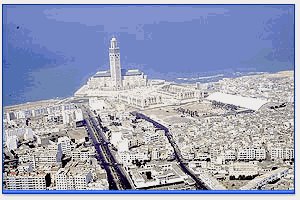
Casablanca is an important city, but it always misses out on the tourist dollar compared to Tangier, Marrakech and the wonderful medina of Fez. Cassablanca is often used as little more than an entry and exit point with maybe a quick tour to the Hassan II mosque before travellers head on to the rest of the country.
Now it seems that the good folk of Casa are fighting back and a flurry of articles extolling the wonder of Casablanca are appearing.
Here's an example from a British tour site:

Although Casablanca has been romanticised by Hollywood, the place itself is now a far cry from how it was portrayed; it is actually a modern city, but nevertheless beautiful in its own right.
The Portuguese founded Casablanca, but it was never a very important town. The French came into Morocco in the beginning of the 20th century, and Casablanca's status improved drastically.
The old cities of Fes and Marrakech started to loose their importance in the commerce industries and many of the merchant families moved to Casablanca, knowing that the real money was to be made on the coast.
The centre of Casablanca is fairly impressive. It has big, lively boulevards and high, well-kept buildings, and it's clean and efficient.
The city is modern in a Moroccan way, and an excellent example of Moroccans' capacity of taking charge of the future of their country.
However, the one area that depicts the Casablanca of Bergman and Bogart is the old city. It's small, consisting mainly of smaller houses, which all seem to be from this century, and the alleyways dominating in other old cities are rarely found.
The Beaches: Bouznika beach is located between the major cities of Casablanca and Rabat. This beach has become on of the trendiest beaches and golf resorts in Casablanca. It attracts the local weekend and summer tourists. Bouzinika is the ideal destination for people who wish to combine great golfing and a fabulous beach in a unique Moroccan experience.
Agadir beach offers long, wide beautiful beaches with gorgeous white sand. There are various sea sports on offer and you could even rent a camel and go for a ride along the beautiful beach.
Ain Diab beach has many clubs, which line the oceanfront, but the beach itself is really quite enjoyable, and perfect to sit and enjoy the day.
Shopping: The city has a laidback feeling to shopping, however it is one of the better places in all of Morocco to pick up something unique.
The Houbous offers a great variety of crafts and typical Moroccan shops where you can buy all you need and even find that special gift for the important person back home.
The Old Medina is a market zone with excellent shopping opportunities where the narrow streets lead to various souks and bazaars, which sell almost anythin you can imagine.
Tags: Morocco Casablanca Maghreb news

3 comments:
Perhaps that is the big problem that no one can find the romantic Casablanca they think they know from the movie. Apart from the first airport sequence the entire studio-oriented film was shot in a Warner Bros. Hollywood/Burbank studio.
The big attraction in Casablanca should be the Hassan II Mosque. It is formidable.
some corrections !
Before the French Protectorate:
The area which is today Casablanca was settled by Berbers by at least the 7th century. A small independent kingdom, in the area then named Anfa, arose in the area around that time in response to Arab Muslim rule, and continued until it was conquered by the Almoravids in 1068.
During 14th century, under the Marinids, Anfa rose in importace as a port. In the early 15th century, the town became an independent state once again, and emerged as a safe harbour for pirates and privateers, leading to it being targeted by the Portuguese, who destroyed the town in 1468.
The Portuguese established a new town in the ruins of Anfa in 1515, which they named Casa Branca. They eventually abandoned the area in 1755 following an earthquake which destroyed most of the town. The area was reintegrated into Morocco, under the rule of the then sultan Sidi Mohammed III, who renamed the town Casablanca in commemoration of a trade agreement with Spain in 1781.
In the 19th century, the area's population began to grow as Casablanca became a major supplier of wool to the booming textile industry in Britain and shipping traffic increased (the British, in return, began importing Morocco's now famous national drink, gunpowder tea). By the 1860s, there were around 4,000 residents, and the population grew to around 9,000 by the late 1880s [1]. Casablanca remained a modestly-sized port, with a population reaching around 12,000 within a few years of the French conquest and arrival of French colonialists in the town, at first administrators within a sovereign sultanate, in 1906. By 1921, this was to rise to 110,000 [2], largely through the development of bidonvilles.
the source is wikipedia.
you know something the last people that we like to see in Casablanca are the tourists and especiallly the young tourists.
Allah bless Casablanca their folks are good and God likes good people :)
something else there is a lot of attractions in Casablanca ! not only the Hassan 2 Mosque. this is why who lives on it can't leave it and even whom coming from other cities.
as we say : Who enter to Casablanca never exit ;)
Marocain/Casablancais
Salam - and thank you for the comments. As we said at the beginning of the post, the article was from a British tourist site, so I don't think we could have expected much scholarship :)
Mind you, I don't think saying that you don't like to see young tourists is going to be very popular with the thousands of Moroccans who rely on them for their livelyhood! Most Moroccans are genuinely welcoming of tourists.
Post a Comment